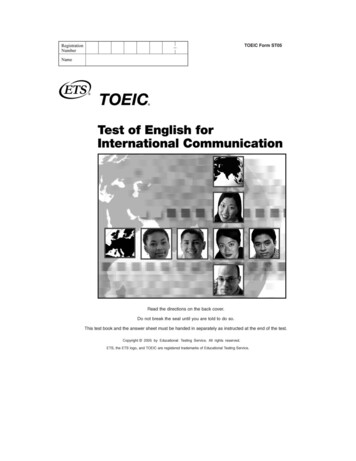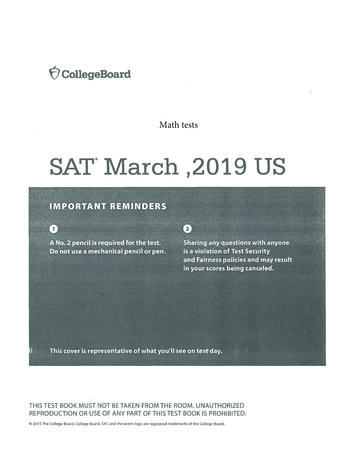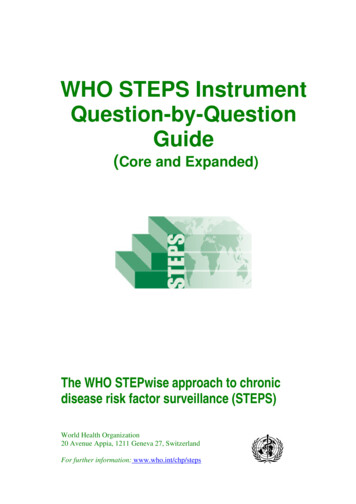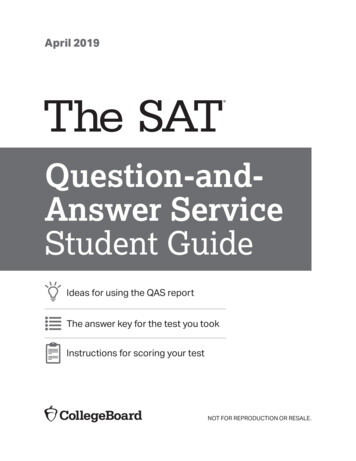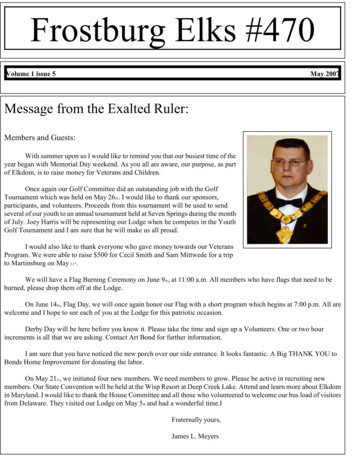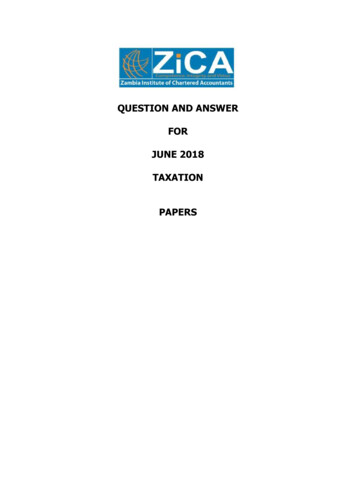
Transcription
QUESTION AND ANSWERFORJUNE 2018TAXATIONPAPERS
TAXATION PROGRAMME EXAMINATIONSCERTIFICATE LEVELC1: BUSINESS MANAGEMENTMONDAY 11 JUNE 2018TOTAL MARKS – 100; TIME ALLOWED: THREE (3) HOURSINSTRUCTIONS TO CANDIDATES1.You have fifteen (15) minutes reading time. Use it to study the examination papercarefully so that you understand what to do in each question.2.This question paper consists of FIVE (5) questions of twenty (20) marks each. YouMUST attempt all the FIVE (5) questions.3.Enter your Student number and your National Registration Card number on the frontof the answer booklet. Your name must NOT appear anywhere on your answerbooklet.4.Do NOT write in pencil (except for graphs and diagrams).5.Cell Phones are NOT allowed in the Examination Room.6.The marks shown against the requirement(s) for each question should be taken as anindication of the expected length and depth of the answer.7.All workings must be done in the answer booklet.8.Present legible and tidy work.9.Graph paper (if required) is provided at the end of the answer booklet.2
Attempt all the FIVE (5) questionsQUESTION ONE(a)In current business environment, medium-sized organisations are increasingly facingcompetition and environmental change. This inevitably makes such organizationsadopt matrix organizational structures.Required:Discuss briefly six (6) benefits that would accrue to the organization for adopting theMatrix Organization Structures.(b)(12 marks)Managers assume the role of leaders in organizations and may adopt Authoritarian,democratic or laissez – faire styles of managerial leadership.Required:(i)Define the term ‘leadership’(2 marks)(ii)Explain briefly the following managerial leadershipStyles:1.The authoritarian / autocratic style(2 marks)2.The democratic style.(2 marks)3.The laissez – faire style.(2 marks)[Total: 20 Marks]QUESTION TWO(a)The corporate code of ethics (ethical code) guides workers to exhibit ethical behaviorin business organizations.Required:(i)Describe Corporate Code of Ethics and outline any three (3) principles ofethical code of ethics.(ii)(5 marks)Outline any five (5) values that would promote ethical behavior amongworkers in business organisations.(b)(5 marks)Partnership forms of business organizations are common among Law and Auditingfirms and are established, among other reasons, to pool resources such as skills,experiences, knowledge, finances and assets.Required:Explain any five (5) advantages and five (5) disadvantages of Partnerships as forms ofbusiness organizations.(10 marks)[Total: 20 Marks]3
QUESTION THREE(a)State five (5) characteristics that distinguish a public limited company from a soletrader.(b)(10 marks)Explain how the social and demographic factors may affect demand of a product.(10 marks)[Total: 20 marks]QUESTION FOUR(a)Briefly explain any five (5) reasons why communication is important to businessorganisations.(10 marks)(b)Discuss the five (5) leadership styles according to Blake and Mouton managerial grid(10 marks)[Total: 20 marks]QUESTION FIVEThe marketing Function in business organizations is tasked with responsibility of conductingmarketing research aimed at reducing barriers that may hinder the implementation ofmarketing plans.(a)(b)(i)Describe the concept of marketing mix(2 marks)(ii)Outline the steps you would take in conducting Market research(8 marks)Explain any five (5) barriers that hinder the implementation of marketing plans.(10 marks)[Total: 20 Marks]END OF PAPER4
C1- BUSINESS MANAGEMENT SOLUTIONSSOLUTION ONEMatrix structures use cross-functional communication links and elements of supervision inorder that complex operations involving a number of functions may be properly co-ordinated.A common approach is to superimpose a customer-focused managerial structure that cutsacross the normal vertical functional management hierarchy.The benefits or advantages that may accrue to the organizations that adopts matrixorganization structures include:(i)Improves Flexibility: - Matrix structures are flexible: project teams can be puttogether, amended and disbanded as required.(ii)Efficient use of resources:- Matrix structure makes good management ofresources which includes human resources.(iii)Boosts team work:- Matrix structure improves team spirit among tructuresimprovescommunication among employees and management.(v)Employee empowerment:- matrix structures builds employee empowerment inthe staff involved in projects supervision/leadership(vi)Information flow:- Matrix structure promotes interdisciplinary information flowwithin organisational structures(vii)Project integration:- Matrix structure is a sure way to integrate projectobjectives in an organization.B (i) Leadership Definition;Leadership may be defined as getting others to follow or getting people to do things willingly orthe use of authority in decision-making. It is related to motivation, interpersonal behaviour andthe process of communication. It may also be referred to as a relationship through which oneperson influences the behaviour or actions of other people To people outside the organizationthe manager might not necessarily be seen in a leadership role. The emphasis of Leadership ison interpersonal behaviour in a broader context. It is often associated with the willingness andenthusiastic behaviour of Leadership which does not necessarily take place within the hierarchicalstructure of the organization5
The style of managerial leadership is usually exercise within the confines of an organizationtowards subordinate staff and may take the following formats:(i) The authoritarian /autocratic style:This style is where the focus of power is concentrated on the manager and all interactions withinthe group move towards the manager. The manager alone exercises decision-making andauthority for determining policy, procedures for achieving goal, work tasks and relationships,control of rewards or punishments(ii) The democratic style:In this style of leadership power and/or authority is more with the group/team and there isgreater interaction within the group. That is, the leadership functions are shared with membersof the group and the manager is more part of a team. The group members have a greater sayin decision-making, determination of policy, implementation of systems and procedures(iii) A laissez-faire style:This is the type of leadership where the manager observes that members (or subordinates) ofthe group are working well on their own and he/she consciously makes a decision to pass thepower/authority to members (subordinates) and gives them freedom of action to do as they thinkbest, and does not to interfere, but is readily available if help is needed. Members or subordinatesare left to face decisions that rightly belong with the managerSOLUTION TWOa) (i) Corporate Code of ethics or ethics code may be defined as a written set of guidelinesissuedby an organisation to its workers and management to help them conduct theiractions or business in accordance with its values and ethical standards. For instance Acode of ethics for accountants has been issued by the International Federation ofAccountants(IFAC), which represents all the major accountancy bodies around theworld.Principles of the code include: Integrity Objectivity Professional competence and due care Confidentiality Professional behaviour6
(ii) Values that would promote ethical behaviour in business organisations OpennessFor example, employees must be open with their managers if an accounting error isfound. Trying to cover it up could not be considered ethical. TrustFor example, employees must trust that their managers, because of their knowledgeand experience, give good guidance and direction. HonestyThis does not need much expansion, but it is important that honesty with colleagues,suppliers and customers is encouraged. RespectThis will encourage the proper treatment of stakeholders and reduce the chance thatthey are treated unethically. EmpowermentEmployees should be empowered to ‘do the right thing’ and to refuse to behave inaway they know to be contrary to the organisation’s ethical code. AccountabilityAccountability means that people do not try to avoid issues or obligations. If you aregiven something to do, you should try to do it to the best of your abilityb) Advantages of PartnershipsForming partnerships has several advantages that include the following:i)A Partnership is easy to set up, as it does not involve long costly procedures.ii)Division of labour is possible, as there are many people involved with various skillsand experiences.iii)More people are involved in the business so more capital can be raised.iv)Expenses and management of the business are shared.v)The individuality of each partner is not totally lost, as partners maintain many ofthe personal advantages of the sole proprietorship.vi)There is greater continuity in a partnership than in sole proprietorship. In case ofdeath or resignation, the remaining partners can form a new partnership.vii)Decision-making is consultative leading to improved quality of decisions.viii)A partnership is not required to publish its accounts annually. It is secrecy7
Disadvantages of PartnershipsPartnerships have several disadvantages as include;i)Decisions may be delayed by disagreements among partners.ii) Partners have unlimited liability and are therefore personally liable for the debts of thepartnership. Personal assets are at risk.iii) Lack of capital may limit expansion as it depends on partners for raising capital.iv) When one partner dies or leaves, a new partnership is required, which may be timeconsuming or awkward.SOLUTION THREE(a) Five characteristics that distinguishes a public limited company from a soletrader:(b)(i)A public limited company is formed and owned by more than two people, unlikea sole trader which is owned by one.(ii)A public limited company can sell its shares to the general public through thestock exchange market.(iii)A public limited company has separate legal entity unlike a sole trader whodoes not have. Separate legal entity means that in the shareholders or ownersare separate from the affairs of the company, this is because in law a companyis considered to be a person with its own rights.(iv)Shareholders/ owners of a public limited company have limited liability unlikesole trader who has unlimited liability. Shareholders have limited liabilitybecause in the event where a company fails to honour its financial obligations,creditors cannot reposes shareholders private properties.(v)Public limited company raises large amounts of capital by selling shares andborrowing unlike sole trader who raise small amount of capital.(vi)There is continuity of business even if one shareholder dies, unlike sole traderswhose businesses mostly discontinue once the owner dies.Changes in the social and demographic factors may affect demand of a productto either increase or decrease. The following are the factors that may causedemand to increase or decrease:Religion and cultural beliefsReligion has a strong influence on what the followers must consume, how the productsmust be packed and advertised. Without following the cultural beliefs the product maynot be accepted by the target market.8
LifestyleDemand of certain goods is dependent on the lifestyle of a particular social class.Therefore, certain good’s demand is influenced by lifestyle.Age distributionCertain products are specifically consumed according to age group. The increase inthe population for a certain age group may increase the demand for a group. Forinstance in the clothing industry certain fashions are targeted at youths who comprisethe largest percentage of the population.Education levelsThe educated population mostly comprises of the middle class in an economy. Thismeans that they are able to access most of the basic needs and therefore the demandfor basic needs such as food, shelter usually increases.SexTheir certain products that are produced specifically for female or male, also considerwho has more influence in making household buying decision. For female are highlyinfluenced by fashion and would like to buy novelty goods. (10 marks)SOLUTION FOUR(a) Importance of communication in business organisation(b)(i)Communication enables the business organisation to inform the public of thegoods and services being offered through advertising.(ii)Communication makes it possible for the instructions to be issued out bysuperiors to perform tasks either through written or verbal.(iii)Communication enable ideas to be shared among workers at different levels ofhierarchy and business decisions are made.(iv)Communication enables the company to receive complaints from customers anduse the information to improve on goods and services.(v)Communication enables the business to enter new markets both local andinternational markets.(vi)Communication makes it possible for the organisation to be in contact withstakeholders such as suppliers, banks etc(i)(ii)1.1 Impoverished: This point shows that the manager little concern for bothworkers and production, he/she is lazy.1.9 Country Club: The manager is employee oriented which means he/shepays more attention to employees than production or task.9
(iii)(iv)(v)9.1 Task: The manager is more concerned with tasks to be performed thanrelationships with employees.5.5 Middle of the road: The manager is at the middle where he/she showsequal concern for production and employees.9.9 Team Management: This is the ideal leadership style where the managershows high concern for production and employees.SOLUTION FIVEMarketing mix elements is crucial tool to help understand what the customers want as theyaffect the consumer decisions to buy or not. They are price, product, promotion, place.a) The market research process he can usei.Define the problem and research objectives.ii.Develop the research plan for data collection.iii.Data collection and analysis.iv.Interpreting and reporting the findings.b) The barriers that hinder the implementation of marketing plans are:i.Management culture this is when them seem not to care about marketing plansii.Political intervention from government legislationiii.Lack of leadership skills and absence of appropriate mix of leadership skills andknowledgeiv.Barriers from competitors who may make it hard by simply getting into your wayand hinder implementationv.Organisation structure , that is bureaucratic bottlenecks ,like infighting for turfvi.Distributors and resource suppliers delays in delivery of your inputsvii.Few or experiencing a dwindling customer baseEND OF SOLUTIONS10
TAXATION PROGRAMME EXAMINATIONSCERTIFICATE LEVELC2: ECONOMICS & FINANCIAL MATHEMATICSTUESDAY 12 JUNE 2018TOTAL MARKS – 100; TIME ALLOWED: THREE (3) HOURSINSTRUCTIONS TO CANDIDATES1.You have fifteen (15) minutes reading time. Use it to study the examination papercarefully so that you understand what to do in each question.2.This question paper consists of FIVE (5) questions of twenty (20) marks each. YouMUST attempt all the FIVE (5) questions.3.Enter your Student number and your National Registration Card number on the frontof the answer booklet. Your name must NOT appear anywhere on your answer booklet4.Do NOT write in pencil (except for graphs and diagrams).5.Cell Phones are NOT allowed in the Examination Room.6.The marks shown against the requirement(s) for each question should be taken as anindication of the expected length and depth of the answer.7.All workings must be done in the answer booklet.8.Present legible and tidy work.9.Formulae are provided in a separate booklet.10.Graph paper (if required) is provided at the end of the answer booklet.11
Attempt all FIVE (5) questionsQUESTION ONE(a)Use a diagram to explain how the consumption of merit goods like education cangenerate positive externalities for society.(b)(5 marks)Consider this statement from a politician during a public debate: “Banks do not createmoney because this is the responsibility of the Bank of Zambia”. Do you agree ordisagree. Explain your answer.(c)(3 marks)Explain any three (3) traditional methods used by the Bank of Zambia to controlmoney supply.(12 marks)[Total: 20 Marks]QUESTION TWO(a)The World Trade Organisation (WTO) seeks to promote greater economic growth,increased consumer choices, reduced costs of production, and goodgovernance, among other things.Explain how the WTO can achieve each of the four (4) aims mentioned above.(8 marks)(b)Cost, Insurance and Freight (CIF) is an incoterm used when the mode of transportinggoods is by sea and by inland motorways.Describe any TWO (2) responsibilities for the buyer and any TWO (2)responsibilities for the seller under CIF.)(4 marks)(c)Discuss any two (2) arguments for and any two (2) arguments against the use ofprogressive taxation in a developing country like Zambia.(8 marks)[Total: 20 Marks]12
QUESTION THREE(a)PJ Limited is a manufacturing company involved in undertaking high risk projects. Thecompany is considering investing in a project which requires an initial outlay ofK50,000.00 according to the company’s cash flow projections over the next four yearperiod, the following net cash flows are expected:Year0Net Cash Flow (ZMK) (50,000)118,000225,000320,000410,000(i)Calculate the net present value assuming a 15% cost of capital.(3 marks)(ii)Calculate the net present value assuming a 20% cost of capital.(3 marks)(iii)Calculate the internal rate of return (IRR) of the above project using theresults from (i) and (ii).(iv)(4 marks)If the company requires a minimum rate of return of 17%, recommendwhether or not the project is worthwhile.(b)(c)(2 marks)Define the following:(i)Floater(2 marks)(ii)Coupon Rate(2 marks)A corporation decides to issue 20-year bond in the amount of K 100,000,000.Under the contract, interest payments will be made at the rate of 10%semi- annually. The bonds are priced to yield 5% semi-annually to maturityRequired:What is the issue price of the bond?(4 marks)[Total: 20 Marks]13
QUESTION FOUR(a)In conducting a simple regression model for the number of customers and thearea of advertising sign used to attract customers, the following data wereobtained for six produce stands.Area of advert signNumber ofcustomers0.372400.30.30.250.30.28150 18295210125Calculate the least-squares regression line for these data.(b)At Chipata College of Accounts in Chipata district, 25% of the lecturers are females.35% of the Lecturers are on Part-time. A Lecturer is chosen at random, what is theprobability that the Lecturer is:(i)(ii)(iii)(c)(9 marks)MaleMale and Part-timeFemale or Part-time(2 marks)(3 marks)(2 marks)The average number of claims per hour made to a certain insurance companyis 1.2. What is the probability that in any given hour either two or threeclaims will be received?(4 marks)[Total: 20 Marks]QUESTION FIVE(a)(b)Define the following terms:(i)Yield to Maturity(2 marks)(ii)Price Value of a Basis Point (PVBP)(2 marks)A 10% bond with face value amount K1,000 matures 4 yearsafter issue.Construct the amortization schedule for the bond over its term for the semiannual rate of 8%.(c)(12 marks)Find the present value of K100, 000.00 in perpetuity if the interest rate is 12% perannum.(4 marks)[Total: 20 Marks]END OF PAPER14
C2 -ECONOMICS & FINANCIAL MATHEMATICS SOLUTIONSSOLUTION ONE(a)Merit goods are products which consumers may undervalue but which the governmentbelieves are desirable for consumers as they exhibit positive externalities. Consumersundervalue them because the net private benefit to them is not fully recognised at thetime of consumption and it is unlikely that this external benefit will be taken intoaccount when the consumer evaluates its worth. In the case of education as anexample of a merit good, pupils and students cannot possibly know the specific privatebenefit to them of getting an education which results in the consumer underconsuming.The graph below shows how the failure to recognise the external benefit of consuminga merit good leads to the inefficient free market outcome. The private benefit is lessthan the social benefit.b) Disagree. When a bank makes a loan, it increases deposits, and money supplyincreases by the amount of the loan because money supply includes checkabledeposits. This is different from minting coins or printing notes which is the soleresponsibility of the Bank of Zambia.15
c) The traditional methods used by the Bank of Zambia to control money supply are: Open Market Operations (OMO): This is the buying and selling of governmentsecurities by the Bank of Zambia. Buying government securities creates extra bankreserves and loans, thereby expanding the money supply. Selling governmentsecurities reduces bank reserves and loans, thereby contracting the money supply. Discount rate Policy: This is the rate at which banks borrow from the Bank ofZambia. Lowering the discount rate makes it easier for banks to borrow from the Bankof Zambia and expands money supply. Raising the discount rate discourages banksfrom borrowing reserves from the Bank of Zambia and contracts the money supply. Reserve requirements: This is the money that every deposit taking institution mustdeposit with the Bank of Zambia to meet its legal requirements. Required reserve ratioand the size of the money multiplier are inversely related. Thus, if the Bank of Zambiadecreases the required reserve ratio, the money multiplier and money supply increase.If the Bank of Zambia increases the required reserve ratio, the money multiplier andmoney supply decrease.SOLUTION TWO(a)The World Trade Organisation (WTO) is the only global international organisationdealing with the rules of trade between nations. Among other things, it seeks to:(i) Achieve higher living standards, full employment and sustainable development.The organisation does so by advocating substantial reduction of tariffs and otherobstacles to trade. Trade can be a catalyst for greater efficiency and productivitybecause companies have access to a wider range of high-quality, affordable inputs.They also have access to technology and know-how they could not obtain in aclosed economy as open economies tend to grow faster and more steadily thanclosed economies.(ii) Lower trade barriers through negotiation and operates under the principle of nondiscrimination. The result is reduced costs of production (because imports used inproduction are cheaper), reduced prices of finished goods and services, morechoice and ultimately a lower cost of living.16
(iii) Help increase productivity and to cut costs even more because of importantprinciples enshrined in the WTO system designed to make life simpler and clearer.It involves transparency (clear information about policies, rules and regulations);increased certainty about trading conditions (commitments to lower trade barriersand to increase other countries’ access to one’s markets are legally binding);simplification and standardisation of customs procedure, removal of red tape,centralised databases of information, and other measures to simplify trade.(iv) To help governments take a more balanced view of trade policy. They are betterplaced to defend themselves against lobbying from narrow interest groups byfocusing on trade-offs that are made in the interests of everyone in the economy.Transparency; greater harmony between countries on other aspects of tradefacilitation; clearer criteria for regulations dealing with the safety and standards ofproducts, and non-discrimination also help by reducing the scope for arbitrarydecision-making and opportunities for corruption.(b)The following are the responsibilities of the buyer: To collect the goods at the port of destination To bear all the costs and risks and damage to the goods once they are offloaded To arrange and pay and insurance from the port of destination to their finaldestination in the importer’s country To accept delivery and goods when the appropriate documents e.g. Bill oflading, invoices that have been presented.The following are the responsibilities of the seller: To arrange and pay for freight charges To deliver the goods on board the vessel at the port of shipment To arrange and pay for insurance charges while goods are in transit To pay loading and unloading costs To provide buyer with the appropriate transport document To provide buyer with an invoice for the full value of the goods and relatedcosts.17
(c)Arguments in favour of progressive taxes They follow the ability of the individual to pay. Therefore, higher income individualsare more able to afford to give up more of their income in tax than the lowerincome earners. They enable a government to redistribute wealth. Progressive taxes are hence atool that can help foster equity in income distribution as well as increase theconsumption levels of society because poorer individuals can spend more of theirincomes due to the higher marginal propensity to consume. Progressive taxes are a counter-balance to indirect taxes that tend to be regressive.In this case they make the tax system fairer and balanced.Arguments against progressive taxes It is usually the poorer societies that have the need to use progressive taxes. Themore developed ones do not have so much use for such taxes. Higher taxes on extra corporate profits might discourage investment. In this caseentrepreneurs may be deterred from creating new companies because thepotential return of doing so would not be worth the risks of such an undertaking. Progressive taxes might spur tax avoidance and evasion behaviour becauseindividuals and firms that are subject to higher taxes stand to gain more bytransferring their wealth to other lower tax regions. In practice, however, suchbehaviour exists whether taxes are high or low but to a less extent. If progressive taxes are too harsh on high income earners or on the wealthy, theymay deter initiative and could lead to brain drain where skilled workers opt to goand work outside the country or where investment shifts to other countries.18
SOLUTION THREEa)i.At 15%NPV1 18000 1.15 25000 1.15 20000 1.15 10000 1.10 50000 1 2 3 4 15652 18904 13150 5718 50000 3424ii. At 20%NPV 2 18000 1.20 25000 1.20 20000 1.20 10000 1.20 50000 1 2 3 4 15000 17361 11574 4823 50000 1242iii.IRR r1 NPV2 r2 NPV1 0.15 1242 0.20 3424 0.186690955NPV 2 NPV1 1242 3424.Therefore, the internal rate of return is approximately 18.7%iv) The project is worthwhile because IRR is greater than 17%.b).i)A Floater is a Bond or other debt whose coupon rate changes with marketconditionsii) Coupon Rate is the rate at which the bond pays interest on its face valueat the regular time intervals until the redemption date.c.F C 100000000, r 0.05 , i 0.025 and n 40 1 1 i n CFair Pr ice P F r ni 1 i 1 1.025 40 100,000,000 100,000,000 0.05 0.025 1.025 40 125,513,875.30 37,243,062.37 162,756,937.7019
SOLUTION FOURa) LetX Area of advertisin g signXYY Number of 100.28125 Y 1002 XY 310.15 X X 1.82 0.5478NowS XX X X 22S XY XY n 0.5478 1.8 26 0.5478 0.54 0.0078 X Y 310.15 1.8 1002 310.15 300.60 9.55n6Therefore, S XY9.55 1224.36S XX 0.0078and Y X 1002 1.8 1224.36 167 367.31 200.316 6 Hence, the least –squares regression line isy x 200.31 1224.36x20
b)i) P(F) 0.25P(M) 1-P(F) 1- 0.25 0.75ii) If P(PT) 0.35 than P(FT) 1-P(PT) 0.65 henceP(M and PT) using the AND LAW IS: P(M) x P(PT) 0.75 x 0.65 0.2625iii) P(F or PT) P(F) (PT) - P(F x PT) as they are not mutually exclusive. 0.25 0.35 - (0.25 x 0.35) 0.5125c) Poisson - distribution with 1.2 . Thus, P X x e xx!P X 2 or X 3 P X 2 P X 3 e 1.2 1.2 2 e 1.2 1.2 3 2!3! 0.216859832 0.086743933 0.3036 SOLUTION FIVEa)i.Yield to maturity (YTM) is the interest rate that will make the present valueof a bond’s cash flows equal to market price plus accrued interest.ii.The Price Value of a Basis Point(PVBP) is a measure used to describe how abasis point change in yield affects the price of a bond.Alternatively, it is the measure of absolute value of the change in price ofa bond for a one basis point changes in yield.b)F C 1000 , r 0.05 , i 0.04 and n 821
1 1 i n CP F r ni 1 i 1 1.04 8 1000 1000 0.05 8 0.04 1.04 336.64 730.69 1067.33Bond Amortization TablePaymentOutstanding PeriodicPayment ofPrincipalInterest 6.305041.788.2251027.755041.458.54c) PV a/r 9.6280END OF SOLUTIONS22100000/0.12 K833,333.33
TAXATION PROGRAMME EXAMINATIONSCERTIFICATE LEVELC3: ACCOUNTANCY FOR TAX PRACTITIONERSMONDAY 11 JUNE 2018TOTAL MARKS – 100; TIME ALLOWED: THREE (3) HOURSINSTRUCTIONS TO CANDIDATES1.You have fifteen (15) minutes reading time. Use it to study the examinationpaper carefully so that you understand what to do in each question.2.This question paper consists of FIVE (5) questions of twenty (20) marks each.YouMUST attempt all the FIVE (5) questions.3.Enter your Student number and your National Registration Card number on thefront of the answer booklet. Your name must NOT appear anywhere on youranswer booklet.4.Do NOT write in pencil (except for graphs and diagrams).5.Cell Phones are NOT allowed in the Examination Room.6.The marks shown against the requirement(s) for each question should be takenas an indication of the expected length and depth of the answer.7.All workings must be done in the answer booklet.8.Present legible and tidy work.9.Graph paper (if required) is provided at the end of the answer booklet.23
Attempt all FIVE (5) ques
Disadvantages of Partnerships Partnerships have several disadvantages as include; i) Decisions may be delayed by disagreements among partners. ii) Partners have unlimited liability and are therefore personally liable for the debts of the partnership. Personal assets are at risk.

